When Portland last hosted a bike share demonstration, the concept was still just a twinkle in PBOT’s eye. But now with a green light to accept $2 million in federal seed funding, a similar demonstration held today in downtown Portland put the idea in a much different light.
Now, instead of wondering if bike-sharing will come to Portland, it’s a matter of getting it right when it gets here.
To inform the selection of a bike-share vendor, garner media attention, and to whet the appetite of potential users of the service, the Bicycle Transportation Alliance (BTA) hosted a demo of bike-sharing systems in downtown Portland today. Two of the most popular systems in the world — B-cycle and Bixi — were on display and open for testing.
B-cycle is a collaboration between Trek, Humana Corporation, and PR firm Crispin, Porter + Bogusky. B-cycle is currently in use in 11 U.S. cities including Madison, Denver, Boulder, and Chicago. Bixi was developed by the municipal parking authority of Montreal and is in use in cities around the world. Bixi has been licensed in the U.S. by Portland-based Alta Bicycle Share.
Both systems boast easy and quick rentals with credit card access, integrated RFID technology to track trips and prevent theft, and other latest-generation bells and whistles. B-cycle had a much more impressive display at the demo today, bringing along a fully operational kiosk and docking station.
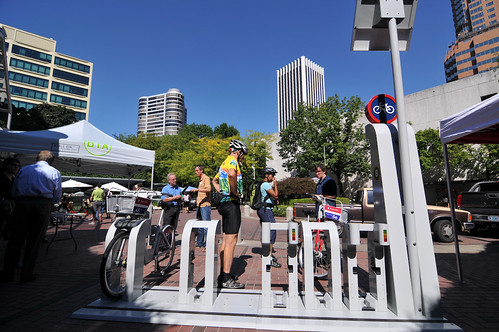
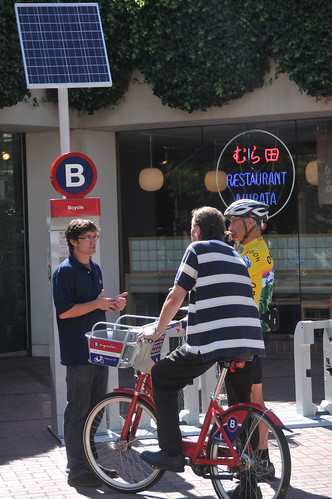
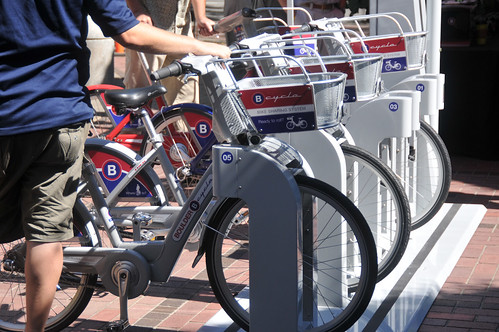
I rode both bikes and preferred the Bixi. The B-cycle was capable and worked fine, I just found the ride of the Bixi a bit more predictable and smooth. The B-cycle has a large front rack that not only makes the front end a bit twitchy/floppy (a few other test riders shared the same feeling), but it also inhibits the rider’s view of the front wheel, which can be a bit strange at first.
Here are more shots of the B-cycle…
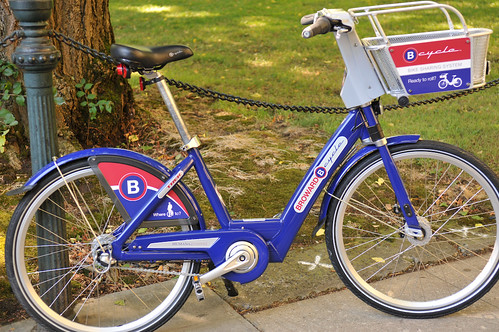
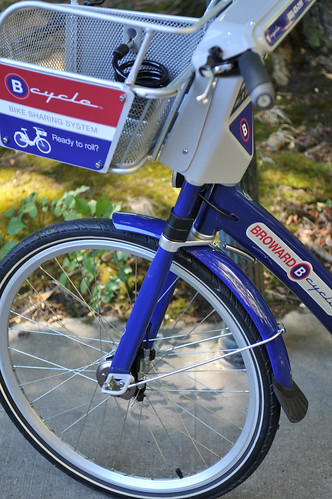

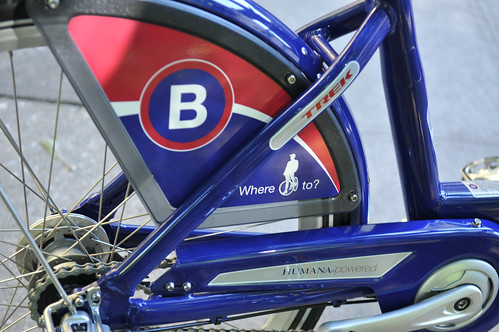
While the B-cycle is essentially a standard city bike with some modifications, the Bixi was clearly built from the ground-up to be the ultimate bike-share machine. With a more proprietary design, it looks more modern and futuristic than the relatively staid B-cycle.
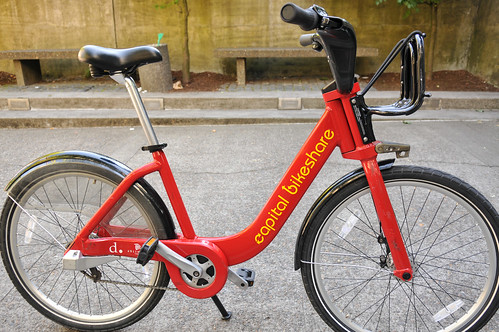
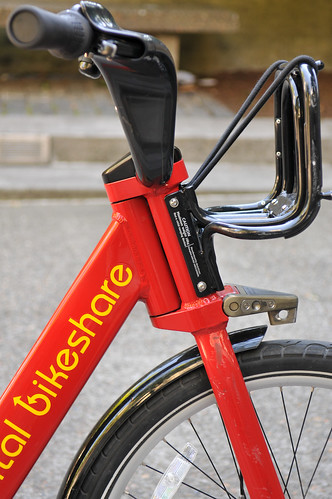
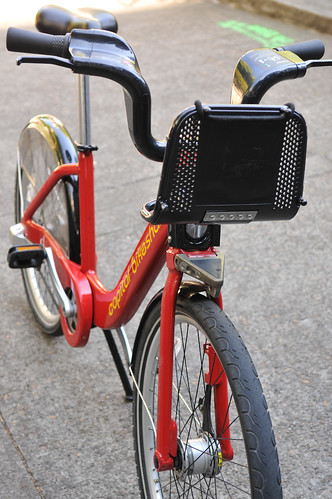
In the end I was left with the feeling that either of these bikes would excel on Portland’s downtown streets. Both have a way to carry a small bag or other cargo in a front rack, both have three-speeds with a wide enough gear range to handle downtown’s hills, and both have very sturdy, weather-proof construction.
Beyond the design and features of the bikes, the bigger question for Portland is whether or not such a system would be popular. If the conversations I overhead are any indication, bike-share will be a big success here.
“I like riding bikes,” said one well-dressed professional prior to a test ride, “but I don’t want to own one. It just seems like such a hassle.”
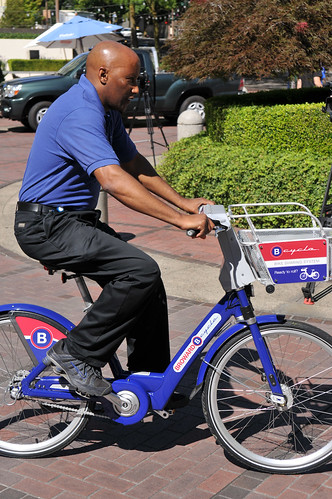
“I heard about this in the newspaper,” said another man on his lunch break, “and it sounded cool. I live in Gresham and would never think about riding all the way into town. But this… yeah.”
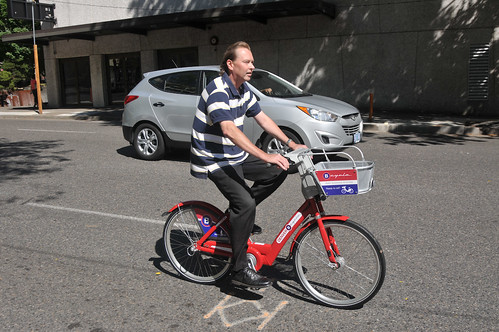
A rep from Regence Blue Cross/Blue Shield I spoke with said he’d use it for short errands across town. Regence has already expressed interest in being a title sponsor of the system. Spokesperson Scott Burton said they see it as a perfect investment. For them, he said, support of bike sharing is a cost-control mechanism and an investment in preventative care. More active people mean lower overall health care costs, which mean lower premiums for Regence members.
With half the $4 million in seed funding needed to start bike share in Portland already in the bank, the next thing is to wait for PBOT’s official Request for Proposals. The RFP — which both B-cycle and Alta Bicycle Share are sure to respond to — will give many more details about what type of system Portland is looking for, how they’ll pay for it, and what they’ll be looking for in a vendor.
— Read more coverage of today’s bike share demo from The Oregonian.


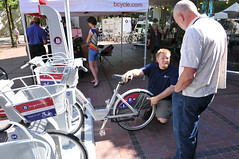



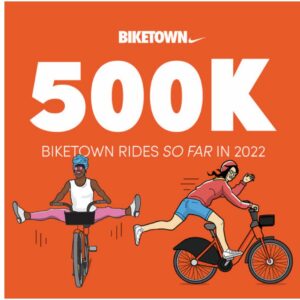
Thanks for reading.
BikePortland has served this community with independent community journalism since 2005. We rely on subscriptions from readers like you to survive. Your financial support is vital in keeping this valuable resource alive and well.
Please subscribe today to strengthen and expand our work.
The solar panel doesn’t mean the system is off the grid, especially considering that solar flux is cut by about 75% on cloudy days and panels generally produce only 8-10 watts per square foot. This doesn’t even factor in the location of the panels in downtown areas where useable solar energy will be severely restricted by buildings. It may offset a minor amount of the power usage, but these panels really serve as useless greenwashing, adding cost and complexity to an already controversial project. We should be spending that money on better bike facilities for long-suffering residents of outer Portland.
uncle muscles,
i mentioned that about the solar panel because I know that some of these stations do not require electricity. Not sure if that’s the case with B-cycle, but that’s my hunch. I know that’s one of the selling points for Bixi… that the stations are self-sufficient and can therefore be easily moved when necessary.
As for your other comments, I disagree. I don’t think bike-sharing is controversial in Portland. I also think that there are a lot of benefits to trying this downtown. There’s more to being a great bike city that “money on better bike facilities.” We don’t need more bike infrastructure, we need to make bikes more of a priority and make them more enjoyable to use on the infrastructure we already have.
All central city streets are bike facilities in my opinion… we just happen to allow cars to run amok on mostly all of them. I think plopping a bunch of bikes on them will do wonders for traffic calming and will help balance out the traffic mix…. and that this will ultimately lead to the public and political will needed to invest in bike-specific infrastructure when/where it’s necessary.
thanks for your comment.
Actually, the Bixi stations can be on or off the grid. They typcially run off batteries that are housed inside the kiosk and the solar panels deliver power to the batteries to increase the time in between full battery recharges.
In London (which uses the Bixi equipment) the city chose to wire them into the grid, in Boston/DC/Montreal/Melbourne/Toronto the Bixi equipment in those cities is not on the grid but instead runs off the battery/solar combination.
Wish I could have been there! B-Cycle also has too much plastic for my taste.
Just got back from DC, where I rode the red Capitol Bikeshare machines like in the photos. They are indeed capable, but it was sometimes hard to find an open slot near my destination to turn in my bike (usually when it was raining). That added to travel times.
I am guessing they will have to have front lights at least to make them legal in Oregon?
The Bixi bikes have automatic and rear lights that illuminate when you pedal. I understand that the next generation of these lights will have something like 30 seconds of stored up juice for when you’re stopped at a red light, or what have you (e.g., not pedaling).
Thanks, it looked like a generator hub in one of the photos but I didn’t see a light so I wasn’t sure.
Oops I meant to say FRONT AND REAR lights… It looks like you understood though. 🙂
Does anyone have information about bike share planning from past to present? Were there public forums where they talked about where the kiosks would be, what they would look like, would there be advertising, etc? Does that happen after the RFP?
Steve, I did a quick google search and came up with this pdf:
http://www.metrobike.net/index.php?s=file_download&id=16
I’m sure there are other sources available out there as well.
Thanks! Although, I’m looking for public participation info about *Portland* Bike Share. I understand PBOT has been working on it for some time, so I am curious if there have been opportunities to sound in and help shape this project up until present.
The bikes were a very smooth, comfy ride. I think it could be a pretty good service. I have some nitpicky issues that could be overcome with a little creativity.
1: The locks. The B-cycles bike had a thin cable lock that Portland thieves love. The Bixi bike had no lock under the presumption that people wouldn’t be making pit stops or running errands by bike.
2: Helmets. If someone is new to biking in Portland, a helmet option is more than reasonable. I’ve heard the argument about it being potentially unsanitary and the argument that it could have sustained damage between rides and frankly I remain unconvinced by either line. A rental car has dozens of safety devices, any of which could fail between rides. Zipcars get swapped between users with no sanitation or safety check. These services work. No one says “don’t bother with a safety belt” because you don’t know the quality of the belt before you put it on.
3: Performance. I ride probably 20 miles a day just going to and fro and yet taking these up just the most mild of hills took some sweat. Mind you I wasn’t looking for a hill–this was one block from the demo.
Despite the critique, it was a straightforward and simple service. I’d be pleased to have it downtown so I can convince friends or visitors who don’t normally bike to give it a chance. I live in North Portland but downtown makes sense–given the concentration of people living and/or working there.
John, as someone who works with OHSU, I thought I would pass on an idea my girlfriend had earlier–that once Portland’s bikeshare system gets going, OHSU could use a bikeshare dock or two at the top of the hill to enable people to cruise down. =) (And while they’re at it, why don’t they co-sponsor it with Regence?)
Same goes for all of Portland’s hills. Paris’s hills are easy to go down because the Velib managers don’t mind transporting all the bikes to the top of the hills at the end of the day.
Not a bad idea. Although Marquam Hill’s topography isn’t very friendly to the casual commuter on a cruiser bike (at least when you hit Campus Drive), I could see these stations at South Waterfront, the future Schnitzer Campus (shared with PSU) and PSU’s main campus. These, with a tram assist, would make a great & easy university circuit. The bikes are very heavy, so you’d really get momentum on Sam Jackson (which would understandably make the vendor pretty nervous).
Bike share is not set up for 20 mile rides, only 2 mile rides typically.
I believe the point John was making is that he is in relatively decent shape – riding 20 mile per day – and yet he had a difficult time making one of these bikes make a slight hill. The conclusion is a person who normally rides the 2 mile target distance will never make it up the hills of Portland on this 3-speed everyone bike.
Anybody know the rental cost [you know the line on your CC bill that comes after you’ve taken this bike for a ride and that you have to pay at the end of each month]?
1st 30 minutes free. Dollar first hour and then it gets exponentially higher (to keep them in rotation and to discourage full day rentals [for that we have bike shops]). This is their base. It could vary depending on level of sponsorship from the City, advertisers, etc.
Is there a reason why they have to be so dorky looking? Theft deterrent? What?
I’m gonna guess:
1. Increased durability
2. Unmistakably look like a BikeShare bike
I found the B-line bike to be much more difficult to ride a wheelie on. The Alta Bixi bike seemed like it could take more of a beating, and the fat tires are always a plus in my book.
Mrs Dibbly & I were there this morning. We rode both bikes and talked to the reps at length. We both liked the Alta/Bixi a bit better, but honestly either would work well.
The B-cycle that I rode had a loose headset and a shifter cable that seemed misadjusted as the hub didn’t want to stay in the same gear all the time.
The brakes seemed better on the Alta/Bixi. We both preferred the basket on the B-cycle to the Bixi’s briefcase-holding rack. Mrs Dibbly particularly liked the clear skirt guard on the Alta/Bixi.
The Alta/Bixi had wider tires, so might be less likely to have problems with streetcar tracks.
All of the bikes had Shimano 3-speed hubs but both reps said that 7-speeds were available as well. Both bikes were geared very low. I’d guess that the high gear was about 70 or 75 gear-inches. That makes sense because it’s more important for people to be able to get up hills than to go fast, and, given the intended market, high speeds are probably not a good idea anyway.
The Alta rep said that they plan on a 2:1 ratio of bike spots to bikes. The B-cycle rep said that they use 1.5:1. To me, what that really means is that with a B-cycle system you’re more likely to find a station with no open spots to return a bike. I have no experience with bike sharing systems, so maybe this isn’t a problem in normal use.
One rep (I think it was Alta/Bixi) was asked by another person about locks. The reply was that they weren’t big on offering locks because it encouraged people to hang on to the bikes instead of returning them to a station for someone else to use. I liked that answer.
Both reps made it pretty clear that pricing was pretty much up to the City, but it seemed like most were fairly consistent.
good product review!
Jonathan, what is the main cost in this project? is it the bikes or the infrastructure? It just seems like $2-4 million is a LOT of money and so far I have seen no estimates on the number of share bikes that will be implemented in the project. It’d be interesting to see how the finances play out in this.
The frames look inexpensive but real sturdy and have fairly low-end components on them. Im not saying they are horrible bikes, Im just saying that if you have $2 million dollars you should be able to put a huge number of these across the city. Then again, if the infrastructure for these bikes is real expensive or if these companies are selling the bikes at much higher rates than youd pay for the same quality in the retail bike market, the project wont be quite as widespread and will take away from the ability of this project being sustainable.
Im not criticizing. just trying to bring up good talking points.
good points, though in comparison to other transportation investment this is dirt cheap.
Bill,
The main cost is the start-up, which is estimated to cost $4 million. $2 million of that will come from a federal grant and PBOT says the other 1/2 is set to come from private sources through partnerships and sponsorships. The ongoing costs are for maintenance and operations, which PBOT says will be funded through a mix of sponsorships and user fees.
This project has essentially zero City taxpayer investment.
As I’ve reported in the past, the plans now call for 74 stations and 740 bikes, with stations being about 5 blocks apart.
I’ve covered this stuff in depth in the past… Browse my “bike sharing system” news archives to learn more.
If B-Cycle’s ratio is 1.5 slots-per-bike, that’s one solar-powered, radio-connected (and kind-of bomb-proof) point-of-sale per three bicycles, so you’re spending a lot more on docking infrastucture than you are on bikes. Plus it will cost money to install all of this, and get it online.
I am excited about the concept of bike sharing in Portland. Although I find it interesting that Regence is considering sponsoring it. I got a letter from Regence last week informing me that my premium is going up approx $100 per month.
As a Montreal resident, I would strongly recommend that you pay close attention to the fenders on the bikes. The Montreal Bixis are awful in that respect: the rear fender is so short that your back gets sprayed pretty badly and the front could be longer/mudflapped, too. In Montreal this is maybe not as important, as we don’t have that much rain in the summer and in the winter the system shuts down, but for Portland this seems to be pretty important. From the pictures it appears that the Bcycle is marginally better, but the fenders are still rather short.
Very good point about the fenders. I noticed their (lack of) length, too. That’s a detail that the successful bidder must take care of.
My family and I have traveled twice to Minneapolis in June the past 2 years. We put the Nice Ride System to heavy use as it allowed us a high level of independence during the day while my son was at work. I often would ride with him to work in the morning at the U of M, dock the bike at a kiosk, and then immediately ride to my next destination. The question raised earlier of a lock for the bike is a non issue as you dock the bike at the kiosk and then walk a block or two to your final destination.
Once the five dollar daily fee to access the system was paid the goal for the rest of each day was to return the bike to a kiosk before 30 minutes is up so no additional rental was incurred. Most of the trips in Minneapolis (96%) are less than 30 minutes. For long trips this meant hopping from one kiosk to another and planning the trip well. For this reason I recommend that the kiosks be spaced further apart then I believe has been proposed for the Portland system. This would allow the range of the system to be maximized. The Minneapolis kiosks are about 4 blocks apart in downtown and close to 10 blocks apart on the periphery of the system.
The Nice Ride bikes have 3 speed internal hubs with 26 inch, heavy wheel sets. They are heavy, sturdy bikes with a maximum speed of 15 mph on level ground. The bikes were less than a month old when we went a year ago in June; I was curious to see how beat up they were a year later when we returned. I was pleasantly surprised to see that they were well maintained and still in like new condition.
I was thoroughly impressed by the Nice Ride system and believe a similar system would be a great addition for Portland both as an introduction to new cyclists and visitors from out of town.
FYI: the Nice Ride system uses Bixi bikes and dock stations. There was a Nice Ride bike at the demo.
A few questions:
1) do they both come with locks so that you can lock them up when you are at a coffee shop or park?
2) Could they come with a back rack or basket? I like the front but it looks a little small on Bixi. I would be surprised if it could even carry a briefcase or large purse.
I’m mainly thinking about what I would use it for if I was in a town but without my own bike. I may need to go shopping or out to eat but would need a place to carry stuff back. The B-Cycle front rack looks much more convenient for those activities.
That being said, I haven’t road either of them but think either will be wonderful to have. I’m always having problems finding bikes to fit friends and family that are visiting from out of town.
I saw the Bixi bikes all over Washington DC when there earlier this Summer. Definately a good looking, capable machine…and licensed in the U.S. by a Portland company.
My vote goes for the Bixi!
But it’s a Canadian company under it all.
Why not B-cycle and Trek an American company?
That wouldn’t be bad either. I give it a close “second”. 🙂
I’m confused. Why don’t folks working/living downtown just get their own bikes? That fella from Gresham could just plop his on the MAX and zip around downtown during his breaks.
I think if the bikeshare concept is going to make a real impact, it should be in neighborhoods where people can’t afford to buy a bike, and should be as close to free as possible. This just feels like a toy for a neighborhood that doesn’t need it; a gimmick to raise awareness about bikes. Do we really need anything more than our growing numbers to raise awareness.
If the city is getting grants towards bike-related infrastructure, I think they can figure out a more productive use for that money than giving businesspeople a nifty new way to get a latte.
So let’s look at one trip a week, say to a grocery store on bike share. $5 for the trip under 1/2 hour. So two trips to get your groceries is $10 per week. That’s $520 a year, for one trip a week.
For $520 you can get a good new bike and a damned good used bike at CCC.
Not sure how this helps people who can’t afford a bike.
Currently Nice Bike in Minneapolis has the yearly fee on sale for $40 and $50 for students and adults, respectively. This is about the cost of a tune up at a bike shop. The $5.00 fee for 24 hours is for out of town visitors or rare users that will only need a bike for 3-4 days per year. As long as the bike is returned within 30 minutes there are no other fees or rental charges.
That would be the most expensive way possible. Better to get an annual membership for $50-60. And trips 30 minutes or less are free. By using a bikeshare bike you don’t have to worry about maintenance or theft (as long as you return the bike to a kiosk when you aren’t using it). I do my own maintenance, but have to admit it might be nice to not have to worry about it.
Surely you jest.
They guy working downtown might not have his bike with him every day. My impression is that Trimet is pushing bikeshare as a way to reduce the number of people who bring bikes on transit.